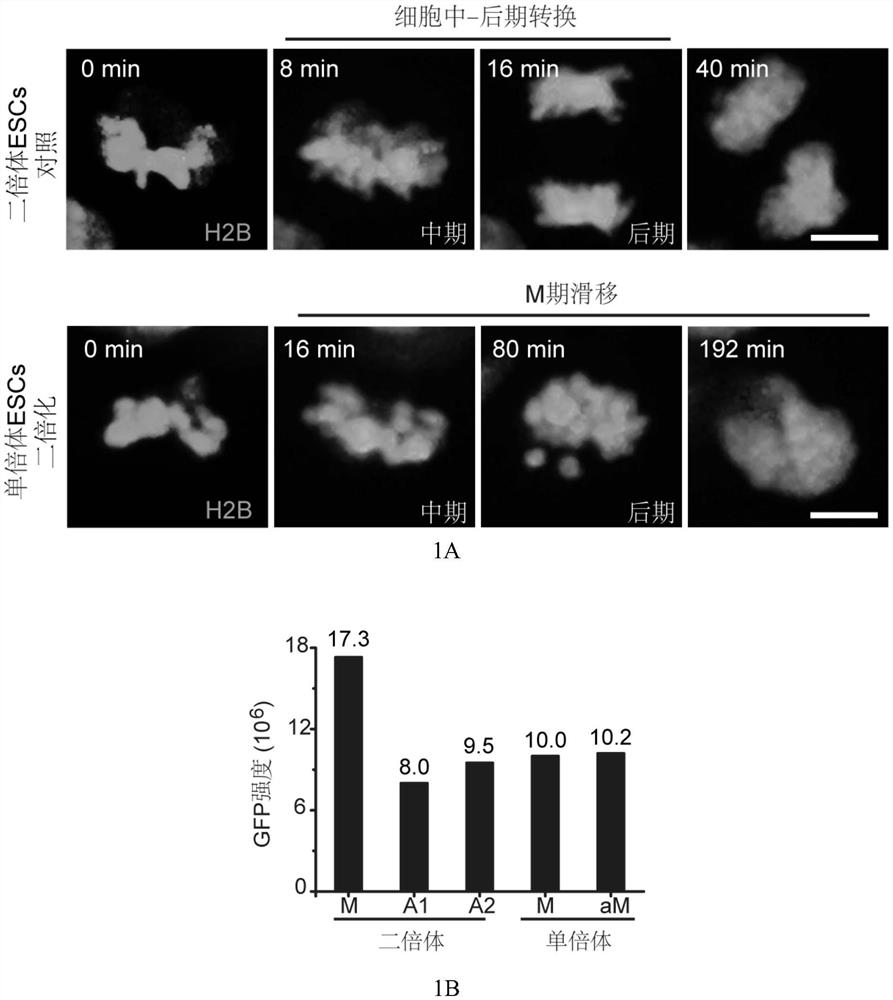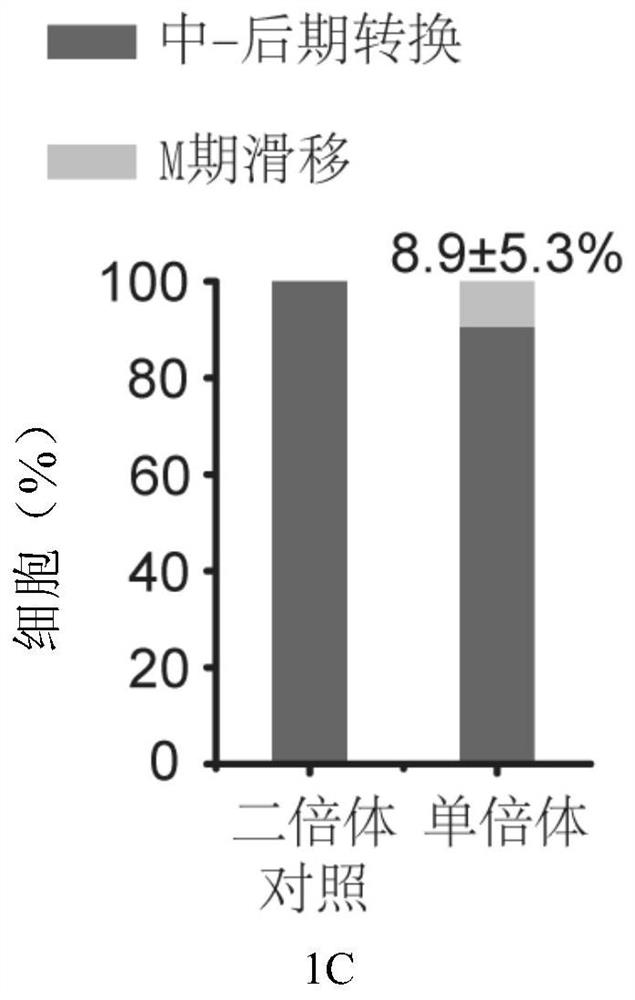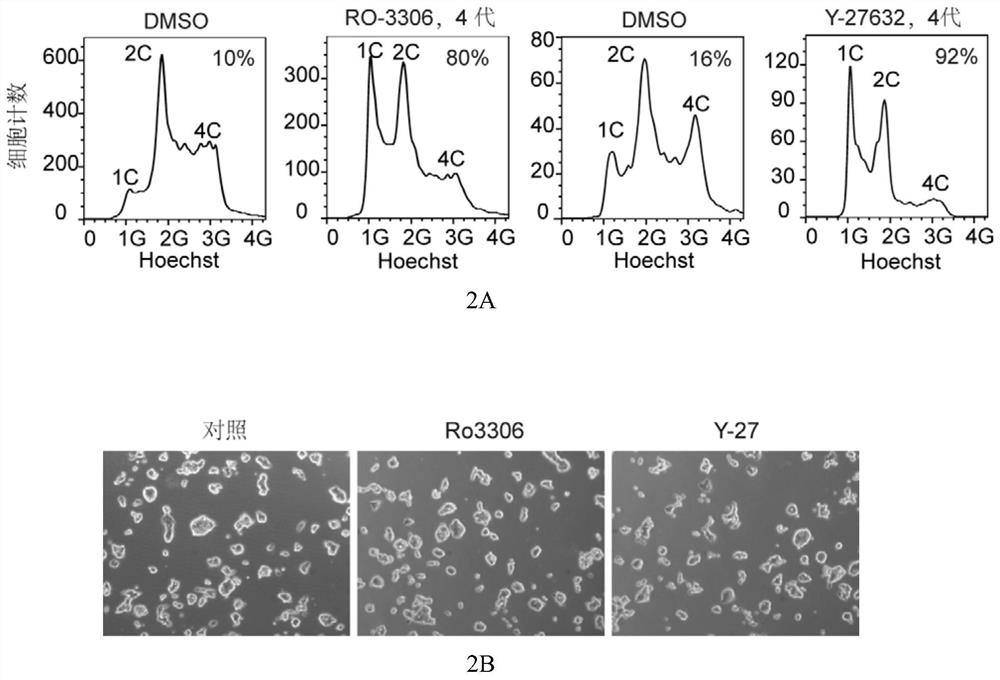Use of protein kinase inhibitors in inhibiting diploidization of haploid cells
A technology of protein kinase inhibitors and haploid cells, applied in the field of haplotype maintenance in in vitro culture or differentiation of haploid cells, can solve the problem of failure to effectively control diploidization of haploid embryonic stem cells, ineffective Obtain haploid cell genetic screening and other issues to achieve the effect of simplifying the culture program and reducing costs
- Summary
- Abstract
- Description
- Claims
- Application Information
AI Technical Summary
Problems solved by technology
Method used
Image
Examples
Embodiment 1
[0049] Example 1 Dynamic changes of chromosomes during haploid embryonic stem cell division
[0050] Diploid embryonic stem cell lines derived from fertilized eggs and parthenogenetic haploid embryonic stem cell lines were established from the same strain of H2B-GFP transgenic mice (introduced from Beijing Weitong Lihua Experimental Animal Technology Co., Ltd.).
[0051] Cultures of diploid ESC lines and androgenic haploid ESCs were performed in 12-well plates. First, mouse feeder layer cells (E13.5 day embryonic fibroblasts of mice treated with mitomycin C (sigma, M0503)) were inoculated on culture well plates, and fibroblast culture medium (high glucose DMEM (Gibco, C12430500BT), 1× sodium pyruvate (100×, Gibco, 11360-070), 1× non-essential amino acid (100×, Gibco, 11140-050), 1× Penicillin-Streptomycin (Gibco, 15140163, 100× ) was added with 10% fetal bovine serum (Gibco, 16000-044) for subsequent cultivation. The partheno (parthenogenetic) haploid embryonic stem cells w...
Embodiment 2
[0053] Example 2 Screening of Protein Kinase Inhibitors and Their Concentrations to Inhibit Diploidization of Haploid Cells
[0054] (1) Screening of protein kinase inhibitors and their concentrations in 12-well plates.
[0055] First, feeder cells of mice (mice MEFs treated with mitomycin C (sigma, M0503)) were inoculated on culture well plates, and fibroblast culture medium (same as in Example 1) plus 10% fetal bovine serum (Gibco, 16000-044) for future use. Parthenogenetic (parthenogenetic) haploid embryonic stem cells were stained with live cell dye 2 μg / ml Hoechst 33342 (Invitrogen, H3570) at 37 degrees Celsius for 15-20 minutes, and the 1n peak was collected by flow cytometry, and diploid ES was used as a control to determine 2n peak position. The enriched haploid embryonic stem cells were evenly seeded in a 12-well plate with feeder cells. Using the mouse embryonic stem cell culture medium (same as in Example 1), add a specific concentration and a specific type of ...
Embodiment 3
[0063] Example 3 Haploid Neural Stem Cells Derived from Haploid Embryonic Stem Cells Using a Rock Kinase Inhibitor
[0064] Obtain flow-purified partheno (parthenogenetic) haploid embryonic stem cells, plant 50,000 cells in a 3.5cm culture dish with feeder cells, and grow clones in 3-5 days, 0.25% trypsin (Gibco, 25200 -072) digested for 3-5min, 10% FBS terminated the digestion, washed once with 1×PBS, cultured haploid ES in suspension with mouse embryonic stem cell culture medium without PD0325901, Chir99021 and LIF (same as in Example 1), and cultured in suspension After 2 days, 500 embryoid body spheroids were planted on a 6cm petri dish covered with poly-lysine 1mg / ml (sigma, P6407) and 5ug / ml laminin (invitrogen, 23017-015). After 16 hours, change to neural stem cell culture medium (N2B27 basal culture medium (same as Example 1), add 20ng / ml bFGF (R&D, 233-FB-001MG) and 20ng / ml EGF (R&D, 2028-EG-200)) . Add any Rock inhibitor such as 20 μM Y-27632, and the same dose o...
PUM
 Login to View More
Login to View More Abstract
Description
Claims
Application Information
 Login to View More
Login to View More - R&D
- Intellectual Property
- Life Sciences
- Materials
- Tech Scout
- Unparalleled Data Quality
- Higher Quality Content
- 60% Fewer Hallucinations
Browse by: Latest US Patents, China's latest patents, Technical Efficacy Thesaurus, Application Domain, Technology Topic, Popular Technical Reports.
© 2025 PatSnap. All rights reserved.Legal|Privacy policy|Modern Slavery Act Transparency Statement|Sitemap|About US| Contact US: help@patsnap.com



